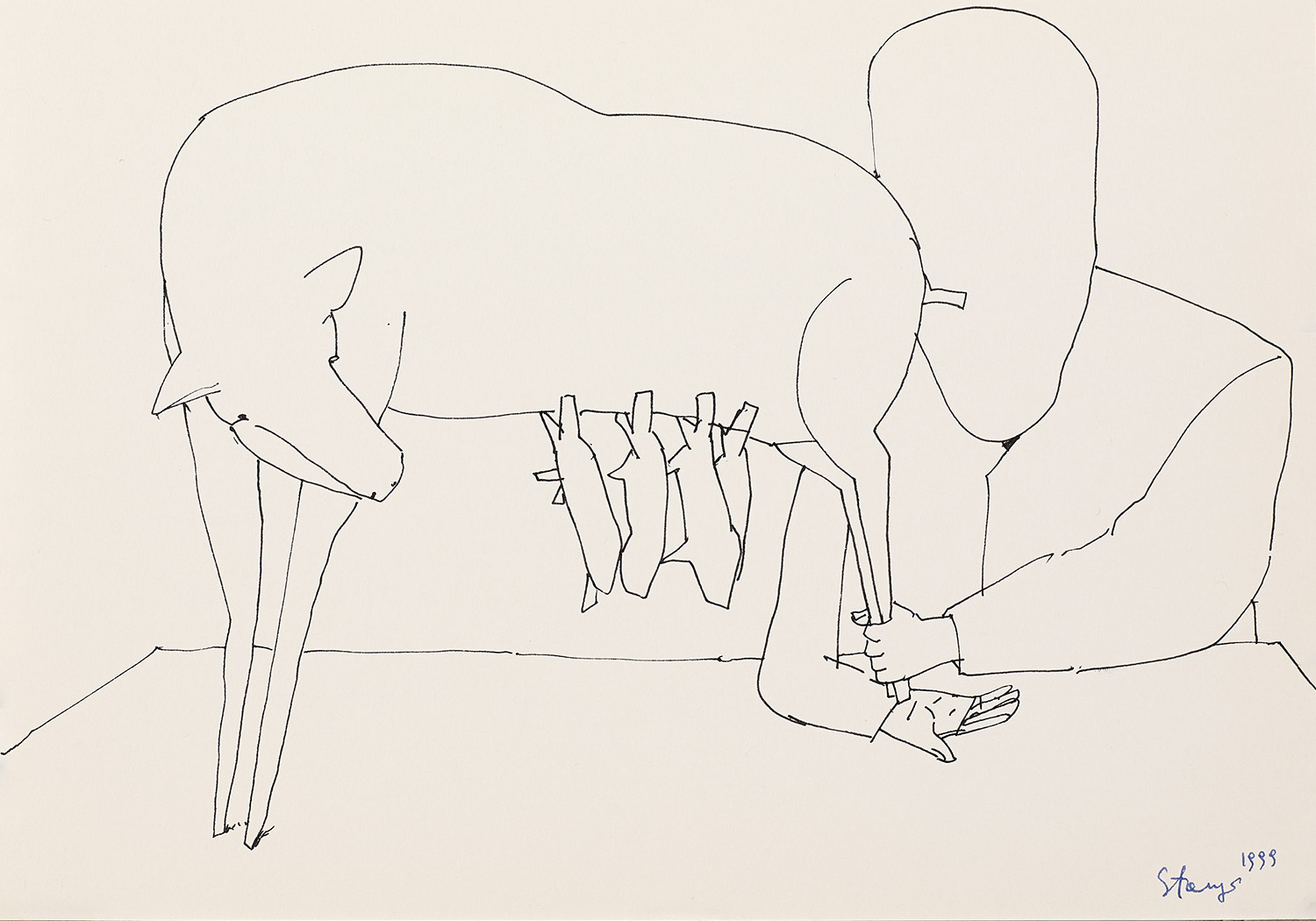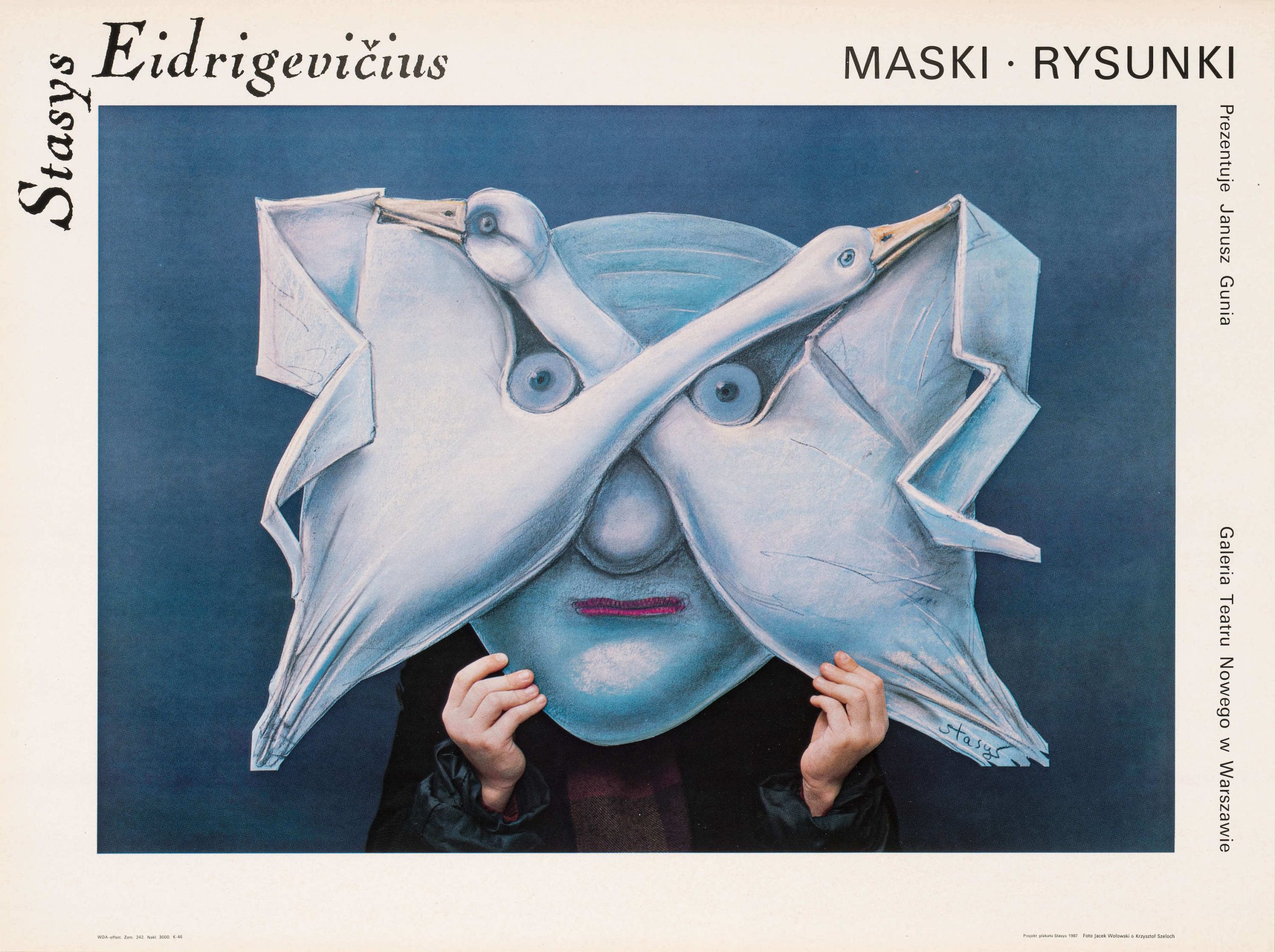Stasys

With more than 100 solo exhibitions in various countries, Stasys opens up the world of his thoughts, experiences, wanderings, and ideas in paintings and graphic works, posters, book illustrations, masks, and one-of-a-kind smudges or Lithuanian sadnesses.
His drawings have been published by The New York Times and other world-renowned publications and magazines, and he has been invited to participate in international art juries and share his experience with students.
Stasys' original plays "The White Stag" and "The Wooden Man" were staged at the Studio Theatre in Warsaw, and he played himself in the film "Bouzkashi" by French film director Jacques Debs. Creativity spills over into the artist's original texts - essays, travel descriptions, or notebooks, where alongside a sketch of a drawing there are phrases that describe the world in a surprisingly apt way. In 2016, Stasys published a poem "Giedanti gaidžio galva" (The Singing Rooster's Head), written in the dialect language, as an anthem to his homeland and his childhood years. The poem, written in dialect, was awarded the Dionysius Poška Prize and recognized as the most creative book of 2016.
Stasys Edrigevičius was born on 24 July 1949 in the village of Mediniškės, Panevėžys county. In 1964-1968 he studied at the Kaunas Stepas Žukas Applied Art Technical School. In 1968-1973 he studied graphic art and painting at the State Art Institute (now Vilnius Academy of Arts). Stasys' teachers were painting legends Jonas Švažas, Rimtautas Gibavičius, and Algirdas Petrulis.
Stasys' work has received more than 40 international awards worldwide: the Grand Prix at the International Book Illustration Competition in Barcelona (1986), the Golden Hugo at the International Poster Festival in Chicago (1987), the Grand Prix at the First International Illustration Biennial in Belgrade (1990). Gold Medal of the Society of Illustrators in New York and the Grand Prix of the Salon des Posters in Paris (1993), Gold Medal of the 4th International Poster Triennial in Toyama, Japan (1994), and the Polish Poster Biennial in Katowice (1999), and many more.
Stasys and Japan share a special bond. For many years he has worked with Japanese artist Hiroko Mori. In 1993, she founded a small, private museum, the Hiroko Mori Stasys Museum, in Otaru, Hokkaido. It exhibits the works of the art friends.
In 2019, Stasys was awarded the Commander's Cross of the Order of Merit of the Republic of Poland, in 2009 he was awarded an Honorary Doctorate of the Vilnius Academy of Arts, and in 2001 he was awarded the Lithuanian National Prize for Culture and Art. In 2000 he was awarded the Order of the Grand Duke Gediminas of Lithuania. Since 1980 the artist has been living and working in Warsaw, Poland.

Where does Stasys begin?
With a white piece of paper. From a pencil. From a dot on a canvas. When Stasys is working, he feels neither cold nor heat, forgetting that time exists. It is as if God were sending him an invisible force, while the artist's hands orchestrate the colors and shapes. "It's often difficult to explain what comes out of all this," he says.
He has been participating in art exhibitions since 1969. His paintings, and graphic works - bookplates, posters, miniatures, book illustrations, photographs, art performances, actions, installations, sculptures, unique masks, and so-called sadnesses have been exhibited in Lithuania, Poland, Japan, Great Britain, Spain, France, Germany, Switzerland, the United States of America, and many other countries. Stasys' works are held in Lithuanian and Polish museums, the British Museum in London, the Museum of Modern Art in New York, the National Library in Washington, D.C., the Vatican Museums, the Tokyo Creation Gallery, and private collections.
The largest collection of Stasys' works - more than 1000 works - is housed and preserved in the artist's birthplace in Panevėžys, STASYS MUSEUM.
"I don't draw a clear line between creative fields. My experiences in bookplates have influenced illustrations and posters, which have influenced paintings, and paintings have influenced posters. It all goes around in circles, but the most important thing for me is that I can express my thoughts in my work," is how he describes the unity of his work.
By choosing the path of metaphors, the artist translates them into different means of expression. On a piece of paper, a notebook, a canvas, a page of a book, a stage, an empty museum hall, a poem, a book, or a magazine page. But at the center of it all is the human being. His many faces and masks.
Stasys is the only one. He has a special, distinctive creative style, an artistic expression that is unique to him alone. He conveys the grotesque, absurd, and paradoxical nature of man and the world, and at the same time, a great love for the everyday moment.
Stasys collection
-
 Stone face / Akmeninis veidas1981, paper/ popierius, 18,5x15
Stone face / Akmeninis veidas1981, paper/ popierius, 18,5x15 -
 Roof / Stogas1981, paper/ popierius, 20,7x14,3
Roof / Stogas1981, paper/ popierius, 20,7x14,3 -
 Legs up / Aukstyn kojom1982, paper/ popierius, 20x16,5
Legs up / Aukstyn kojom1982, paper/ popierius, 20x16,5 -
 A cold bird / Sušalęs paukštis1981, paper/ popierius, 26x19,5
A cold bird / Sušalęs paukštis1981, paper/ popierius, 26x19,5 -
 Bow / Uogos1981, paper/ popierius, 19,3x14,6
Bow / Uogos1981, paper/ popierius, 19,3x14,6 -
 Bicycle / Dviratis1984, paper/ popierius, 21x13,5
Bicycle / Dviratis1984, paper/ popierius, 21x13,5
-
 Dogma
Dogma -
 Fidelite
Fidelite -
 Influance
Influance -
 Intention
Intention -
 Limpid
Limpid -
 Temps
Temps -
 Moment
Moment -
 Reflection
Reflection
-
 Sciana ciszy
Sciana ciszy -
 Statek
Statek -
 Wieza
Wieza
Interviews and articles
-
 Artist Stasys Eidrigevičius - all about laughing until you fall and the sports club under the workshop"One student wrote that there is a lack of happy people in Panevėžys..."Read more
Artist Stasys Eidrigevičius - all about laughing until you fall and the sports club under the workshop"One student wrote that there is a lack of happy people in Panevėžys..."Read more -
 "ArtVilnius'23". Discussion "STASYS MUSEUM phenomenon: a new museum for Lithuania"Discussion on the significance of the museum for the country, region, and city. The views on the content and form of Stasys Museum will be discussed, as well as the origin of the name and brand will be revealed.Read more
"ArtVilnius'23". Discussion "STASYS MUSEUM phenomenon: a new museum for Lithuania"Discussion on the significance of the museum for the country, region, and city. The views on the content and form of Stasys Museum will be discussed, as well as the origin of the name and brand will be revealed.Read more


























































